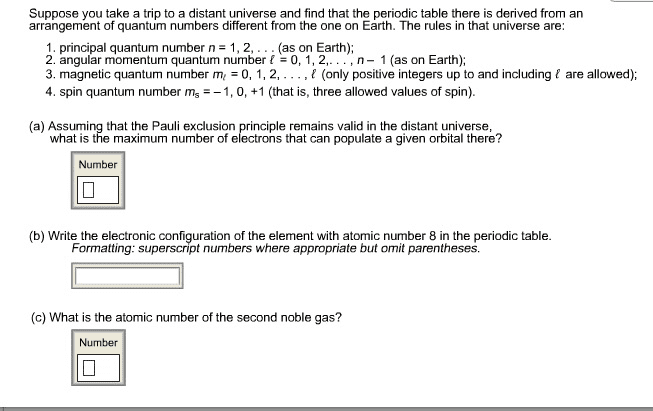The quantum rules any electron state are that n can be any integer > 1, l can be any positive integer less than n, ml can be any integer from -l to +l, and ms has only two possible values: ±1/2.
a) Keeping the rule that n > 1, create an alternative universe by making a change to one of the other quantum rules â that is, change the restrictions on the allowed values of l, or ml, or ms. For example (no one can use these, of course), you might choose to say that l be any positive integer less than n2 in the alternate universe. Or, you could say that ms has seven possible values, -3, -2, -1, 0, 1, 2, or 3. The rule change can't restrict any of the quantum numbers to just one possible value. Don't copy alternative rules from any example â invent your own. You're welcome to send potential rules to the instructor for a check before proceeding.
b) Write out and count the total number of states in the two lowest energy shells (n = 1, n = 2) in your universe. Identify states by giving all four quantum numbers {n, l, ml, ms}, for example {2, 0, 0, +1/2}.
c) The so-called noble gases in our universe are (for the most part) atoms that, when neutral, have electrons completely filling every shell that has any electrons at all. For example, neutral helium (He) has 2 electrons, and there are two states in the n = 1 shell, so the electrons in He completely fill the first shell, and He is a noble gas. Given your results in (b), what would the first two noble gases be, in your universe? Explain.
The quantum rules any electron state are that n can be any integer > 1, l can be any positive integer less than n, ml can be any integer from -l to +l, and ms has only two possible values: ±1/2.
a) Keeping the rule that n > 1, create an alternative universe by making a change to one of the other quantum rules â that is, change the restrictions on the allowed values of l, or ml, or ms. For example (no one can use these, of course), you might choose to say that l be any positive integer less than n2 in the alternate universe. Or, you could say that ms has seven possible values, -3, -2, -1, 0, 1, 2, or 3. The rule change can't restrict any of the quantum numbers to just one possible value. Don't copy alternative rules from any example â invent your own. You're welcome to send potential rules to the instructor for a check before proceeding.
b) Write out and count the total number of states in the two lowest energy shells (n = 1, n = 2) in your universe. Identify states by giving all four quantum numbers {n, l, ml, ms}, for example {2, 0, 0, +1/2}.
c) The so-called noble gases in our universe are (for the most part) atoms that, when neutral, have electrons completely filling every shell that has any electrons at all. For example, neutral helium (He) has 2 electrons, and there are two states in the n = 1 shell, so the electrons in He completely fill the first shell, and He is a noble gas. Given your results in (b), what would the first two noble gases be, in your universe? Explain.

